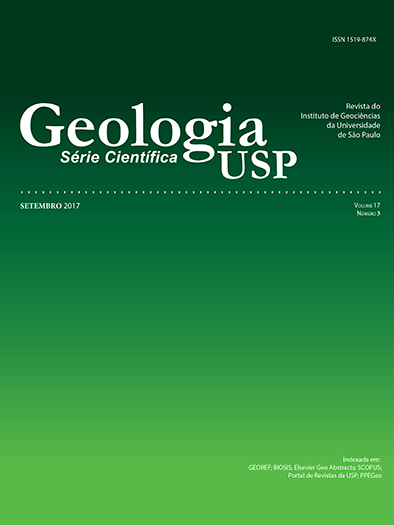Petrography and lithochemistry of ferriferous rocks in Rio Grande do Norte central region (Rio Piranhas – Seridó Domain, Borborema Province Northeast, Brazil)
DOI:
https://doi.org/10.11606/issn.2316-9095.v17-125622Keywords:
Iron formations, Petrography, Lithochemistry, Seridó Belt, Rio Grande do Norte.Abstract
Ferriferous occurrences in the state of Rio Grande do Norte, Brazil, essentially correspond to small deposits without apparent economic potential, but small deposits of this mineral have been well exploited in some areas of this region. The iron formations occur as decimeters to tens of meters layers intercalated with the Jucurutu Formation gneiss, but less frequently, with metamafic rocks hosted in the gneiss from Caicó Complex. In this work, it is presented a macroscopic and microscopic petrographic characterization of banded iron rocks thin sections, besides the discussion of lithogeochemistry data and the use of MEV-EDS to study the qualitative chemical composition of magnetites and amphiboles. These rocks are formed by Fe2O3 content ranging between 46 and 59% and SiO2 content ranging between 33 and 50%. Petrographically, there were identified two distinct groups: granular ferriferous rocks and banded iron rocks. The lithogeochemistry permited to conclude that groups of granular and banded iron rocks sometimes present a similar behavior, sometimes not. The rocks are mainly composed of Si and Fe, with small proportion of trace and rare earths elements. The chemical parameters indicate dominantly oxidant environment and groups of rocks, since intermediate positions to closest the oceanic hydrothermal vents. The tectonic environments for the formation of granular and banded iron rocks studied indicate mainly oceanic chains located next to active continental margins transitional to island arc.
Downloads
Downloads
Published
Issue
Section
License
Authors who publish in this journal shall comply with the following terms:
- Authors keep their copyright and grant to Geologia USP: Série Científica the right of first publication, with the paper under the Creative Commons BY-NC-SA license (summary of the license: https://creativecommons.org/licenses/by-nc-sa/4.0 | full text of the license: https://creativecommons.org/licenses/by-nc-sa/4.0/legalcode) that allows the non-commercial sharing of the paper and granting the proper copyrights of the first publication in this journal.
- Authors are authorized to take additional contracts separately, for non-exclusive distribution of the version of the paper published in this journal (publish in institutional repository or as a book chapter), granting the proper copyrights of first publication in this journal.
- Authors are allowed and encouraged to publish and distribute their paper online (in institutional repositories or their personal page) at any point before or during the editorial process, since this can generate productive changes as well as increase the impact and citation of the published paper (See The effect of Open Access and downloads on citation impact).





